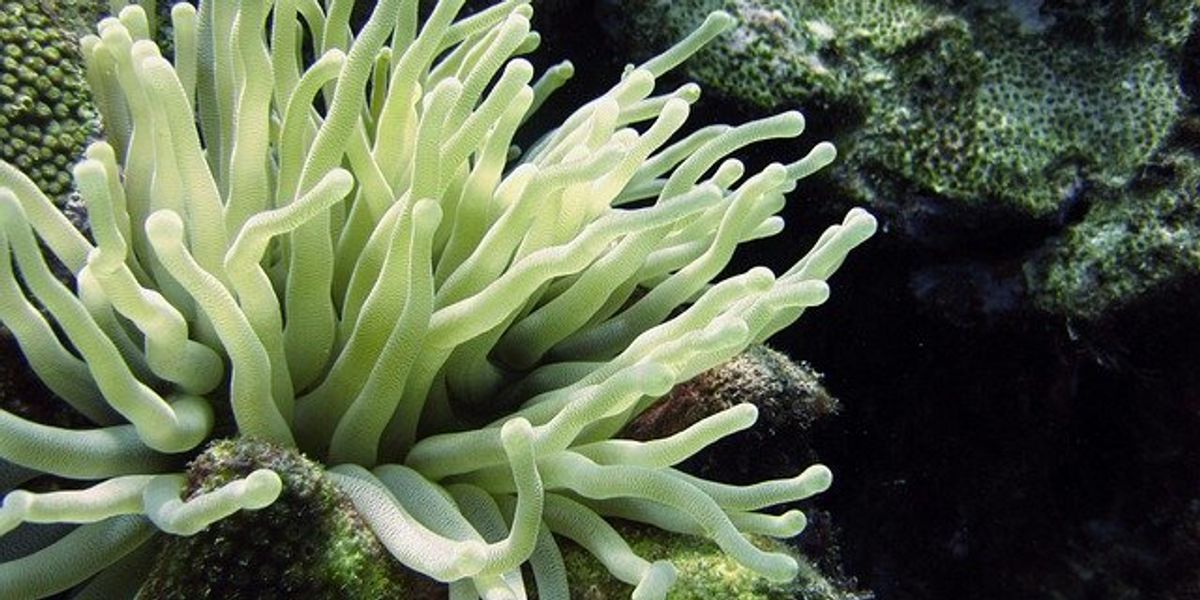climate geoengineering
Geoengineer the planet? More scientists now say it must be an option
Radical plan to artificially cool Earth's climate could be safe, study finds
Experts worry that injecting sulphur dioxide into the atmosphere could put some regions at risk.
Governments seek U.N. scrutiny of technologies to cool the climate
"We need to have an understanding on the implications of using such technologies, and how they would be governed in the future," says assembly chief.
Geoengineering debate shifts to UN environment assembly
Carbon-sucking technology needed by 2030s, scientists warn.
As efforts to cut planet-warming emissions fall short, large-scale projects to suck carbon dioxide out of the atmosphere will be needed by the 2030s to hold the line against climate change, scientists said on Tuesday.
"It's an unavoidable truth: we will need geoengineering by the mid-2030s"
By Laurie Goering
LONDON, Oct 10 (Thomson Reuters Foundation) - As efforts to cut planet-warming emissions fall short, large-scale projects to suck carbon dioxide out of the atmosphere will be needed by the 2030s to hold the line against climate change, scientists said on Tuesday.
Many new technologies that aim to capture and store carbon emissions, thereby delivering "negative emissions", are costly, controversial and in the early phase of testing.
But "if you're really concerned about coral reefs, biodiversity (and) food production in very poor regions, we're going to have to deploy negative emission technology at scale," said Bill Hare of Climate Analytics, a science and policy institute.
"I don't think we can have confidence that anything else can do this," the Berlin-based chief executive told a London climate change conference.
World leaders agreed in 2015 an aim of holding global warming to 1.5 degrees Celsius above pre-industrial times.
Scientists believe this is key to protecting small island nations from sea level rise, shoring up food production and preventing extreme weather.
Carbon-sucking technologies may even be needed to hold the planet to a less ambitious 2 degrees Celsius of warming, said scientists at Chatham House, a British think tank.
The world has already seen an average of about 1 degree of warming, they said.
"It's something you don't want to talk about very much but it's an unavoidable truth: we will need geoengineering by the mid-2030s to have a chance at the (1.5 degree) goal," Hare said, referring to efforts to cool the planet through engineering.
These ideas include planting carbon-absorbing forests across large areas, then harvesting the wood for energy and pumping the emissions produced underground - a process likely to feature in an Intergovernmental Panel on Climate Change report next year.
Machines might also be developed to capture carbon dioxide directly from the air and pump it underground or otherwise neutralise it.
But efforts to store captured carbon underground are "showing no progress... and even backwards steps in some cases", said Corinne Le Quéré, director of the Tyndall Centre for Climate Change Research at the University of East Anglia.
Underground carbon storage has been promoted as part of a push by the United States and other countries to develop "clean coal" technology.
Similarly, planting more forests - a technology known as BECCS, or bioenergy with carbon capture and storage - raises questions about food security and land rights, scientists said.
Le Quéré said BECCS is "probably essential to take us to zero emissions" although "it's really difficult to imagine we can use land at the levels required in the models".
She called for experts to focus on proven approaches, such as improving energy efficiency, promoting cleaner transport, eating less meat and scaling up renewable energies.
Many experts fear that launching costly "negative emissions" technologies could reduce the pressure to act swiftly to cut emissions now.
(Reporting by Laurie Goering @lauriegoering; editing by Katy Migiro. Please credit the Thomson Reuters Foundatio
2 gonzo ideas for slowing down a hurricane that might actually work.
Scientists are looking into ways to weaken hurricanes early on.
Hurricane Maria rampaged through Puerto Rico last week, leaving behind an ongoing humanitarian crisis for the island’s 3.4 million residents who are struggling without electricity and clean water.
With so much devastation, one may wonder whether anything can be done to stop these storms in their tracks.
It’s quite a daunting challenge, given that the average hurricane’s wind energy equals about half of the world’s electricity production in a year. The energy it releases as it forms clouds is 200 times the world’s annual electricity use.
The heat energy of a fully formed hurricane is “equivalent to a 10-megaton nuclear bomb exploding every 20 minutes,” as NOAA meteorologist Chris Landsea has explained.
And these are typical hurricanes, not extraordinarily intense ones like Hurricane Harvey, Hurricane Irma, and Hurricane Maria.
There’s really not much anyone can do once hurricanes like these spool up. Scientists have tried and failed to stop full-on hurricanes in their tracks.
But rising sea levels and increasing average temperatures due to climate change are further expanding the destructive reach of these storms. And with an eye to the potential to save lives and avoid billions of dollars in damage, some engineers and entrepreneurs, including Microsoft co-founder Bill Gates, are studying ways to dial back destruction from a hurricane.
Much of the research is focused on manipulating temperature, moisture, and wind to steer when and where these storms will occur. It involves geoengineering with giant tubes and aerosols. And it’s pretty intriguing — if still quite preliminary.
Scientists have tried to stop hurricanes — and failed miserably
Weather modification has a long, sordid history and hurricanes have inspired some of the more far-fetched proposals, from bombarding cyclones with sonic booms from aircraft to beaming down microwaves from space into nascent storms.
In one of the most infamous attempts to slay a hurricane, Nobel laureate Irving Langmuir led a US military experiment in 1947 to seed Hurricane King with ice in hopes of sapping its vigor. The storm at the time was sliding away from the United States and losing strength.
In an excerpt in the Atlantic from his book Caesar’s Last Breath, author Sam Kean explained Langmuir’s idea: Growing ice in the eye of the hurricane would make the eye grow wider and collapse the storm. But Hurricane King didn’t respond as expected. “To everyone’s horror, it then pivoted—taking an impossible 135-degree turn—and began racing into Savannah, Georgia, causing $3 million in damage ($32 million today) and killing one person,” Kean writes.
Other meteorologists at the time were skeptical that Langmuir’s experiment made the storm change course.
US scientists continued to study seeding clouds inside hurricanes as late as 1983 under Project STORMFURY. But they concluded, according to NOAA, that “cloud seeding had little prospect of success because hurricanes contained too much natural ice and too little supercooled water.”
The remaining tactics for fighting hurricanes require weakening them before they start by deliberately cooling seas and brightening clouds when storms are brewing, robbing them of the fuel for their destruction.
Stephen Salter, an emeritus professor of engineering design at the University of Edinburgh in Scotland, has studied how to harness wave energy since the 1970s, and in 2003 began looking into using this energy to cool the seas.
A less-crazy but still far-out idea: cooling the seas with a giant tube
For ocean temperatures, the magic number for hurricane formation is 26.5 degrees Celsius (or 79.7 degrees Fahrenheit). So what if you could nudge that number down early on and reduce the risks and intensities of ensuing storms?
That was what Salter set out to do.
To cool the surface of the ocean, Salter invented a wave-powered pump that would move warm surface water down to depths as far as about 650 feet.
Made from a ring of tires lashed together around a tube extending below the surface, waves would overtop the ring, pushing the column of water down, while a check valve in the tube would keep it from flowing back.
Salter’s namesake device, the Salter Sink, was invented in 2009 at Intellectual Ventures, a technology firm led by former Microsoft Chief Technology Officer Nathan Myhrvold.
(Microsoft co-founder Bill Gates also filed for a patent in 2009 to cool the ocean’s surface with barges to fight hurricanes.)
The idea is that hundreds of thousands of these devices in hurricane-prone regions of the world would cool waters enough to make a measurable reduction in the strength of storms.
Another promising scheme: making clouds a tiny bit brighter
Salter’s other tactic for fighting hurricanes is making clouds a tiny bit brighter using aerosols, harnessing a phenomenon called the Twomey effect.
This is the observation that for clouds containing the same amount of moisture, the clouds with smaller suspended water droplets reflect more sunlight.
The increased sunlight reflectance in the sky would keep the waters below from warming up to the hurricane threshold while also curbing evaporation, thereby reducing the atmospheric moisture needed to make a storm.
“If you really want to stop hurricanes, I believe that cloud brightening is the better way to do it,” Salter said. Cloud brightening yields a much greater impact on the weather for a much smaller perturbation than directly cooling the ocean, he explained.
Salter envisions unmanned boats spraying sub-micron-sized water droplets into the sky, seeding shinier clouds in areas forecasted to spawn storms.
This would be much cheaper than spraying aerosols from aircraft, the boats could target specific regions, the effects would dissipate quickly and the change in cloud brightness would be imperceptible to the human eye.
He estimated that it would cost $40 million to construct a prototype cloud seeding system but has not been able to find any public or private takers.
“At the moment, the governments are saying its premature, we don't need it yet,” he added. “Irma might change their minds.”
However, Salter acknowledged the prospect of cloud brightening is just an idea at this point. “Most of the work is done in computers,” he said.
One reason diffusing a hurricane is so hard: conditions have to be perfect and they’re often not
For those that have tried out weakening the ingredients of hurricanes in the real world, the results have been disappointing.
Atmocean, a company developing ways to harness energy from ocean waves, looked into making devices to cool the surface of the ocean after Hurricane Katrina in 2005.
Unlike Salter’s device, Atmocean’s approach used a contraption to instead bring cooler water from the depths up to the surface.
The test devices proved successful, but only under ideal wave, temperature, and geographic conditions.
“The physics of it work if the conditions are right,” said Atmocean CEO Philip Kithil. “You can in fact reduce the upper ocean [temperature] by a degree Celsius, maybe 2, which would have a measurable effect on the intensity of the hurricane, but the practical concerns were hard to overcome.”
The wave pumps have to be right in the path of a developing hurricane, and they require cool water to be at an accessible depth, which isn’t always the case. It definitely wasn’t the case in late August when Hurricane Harvey barreled through the Gulf of Mexico toward Texas.
“Harvey passed through an area where there was warm water all the way down to the bottom of the ocean,” Kithil said. “If there is no cold water, you can’t change anything.”
According to a study the company conducted looking back at Katrina, they found that they would need to deploy 100,000 pumps over just two days at a cost of $1,000 each, leading to a price tag topping $1 billion to mitigate the effects of the storm.
At those prices, planners have to consider whether that money would be better spent elsewhere, such as evacuations or shoreline hardening, and neither insurance companies nor governments were willing to investigate further.
Reinsurance firm Swiss Re estimated that Katrina led to $80 billion in insured losses.
Kithil noted that the company also had a hard time finding buyers for their devices. “The insurance industry was not willing to invest, since it was too early stage, too hypothetical,” he said. “And governments are not that proactive.”
Atmocean bowed out of the weather modification business in 2007 and has since pivoted toward using wave energy to drive desalination and onshore aquaculture.
Some hurricane researchers are skeptical these schemes will ever work
At the same time, hurricane researchers have grown weary of responding to proposals to slow storms and most remain skeptical that any tactic could be deployed in large enough numbers to have an effect on giant cyclones.
“As a general comment they show a lack of appreciation for the physical scale of hurricanes and simple ignorance of how they work,” wrote Hugh Willoughby, a hurricane researcher at Florida International University, in an email.
Mark Bourassa, associate director of the Center for Ocean-Atmospheric Prediction Studies at Florida State University, echoed the skepticism about scale.
“For sea surface temperature change, you would have to do it over a very large area and you would have to do it quickly,” he said.
These ideas might be useful thought experiments to better understand the makings of hurricanes, but Bourassa noted that there always concerns about unintended consequences, especially about deploying these tactics at scale.
Scientists already have a hard-enough time recognizing hurricane progenitors and figuring out where the storms will go once they’re spinning, so adding artificially brighter clouds and cooler waters to the mix could prove dangerous.
“I’d be really nervous about trying them,” he said.
For now, computer models are the only place to deploy hurricane mitigation tactics, but that hasn’t deterred Salter, who despite his retirement and lack of a patron says he’s “still working seven days a week on it.”
Four radical plans to save civilization from climate change.
In his scorching new book, A Farewell to Ice, Peter Wadhams, head of the Polar Ocean Physics Group at the University of Cambridge, presents a slew of radical—and sometimes theoretical—ways to save civilization.
SMUG ECO-WARRIORS MAY think they’re curbing global warming with their vegan diets, charged-up Teslas, and rooftop solar panels. But according to Peter Wadhams, head of the Polar Ocean Physics Group at the University of Cambridge, we’re barely staving off disaster. He should know: The pessimistic professor has been studying sea ice for nearly 50 years. “Reducing our emissions is not going to be enough to prevent catastrophic consequences,” he says. In his scorching new book, A Farewell to Ice, he presents a slew of radical—and sometimes theoretical—ways to save civilization.
Carbon Vacuums
One way to reverse global warming would be to hoover up the greenhouse gases that are now making Earth all hot and bothered. “Direct air capture of CO2 is something the whole world should be putting its research money into,” Wadhams says. “The problem is that the level of effort thus far has been much too small; the sense of urgency isn’t there.”
Salt-Spraying Ships
University of Edinburgh engineers designed a fleet of boats that would pipe ocean water hundreds of feet into the sky, spraying the clouds with salt crystals to make them reflect more sunlight. The ships would target areas with persistent marine cloud cover, like the Californian and Chilean coasts.
Sparkle-Blasting Balloons
Researchers in the US and UK have proposed shooting sulfuric acid or sulfur dioxide into the stratosphere using balloons, planes, or artillery shells, effectively filling the sky with sparkles to deflect sunlight. Such aerosol injections show promise, Wadhams says, but introduce environmental dilemmas: They might also deplete the ozone layer.
Supersized Space Mirror
Astrophysicists at the Lawrence Livermore National Laboratory have explored launching a giant mirror or vast expanse of reflective mesh into orbit to protect the planet from the sun. But Wadhams remains skeptical: “Nobody has come up with a feasible plan for assembling this that doesn’t carry a colossal cost.”

















